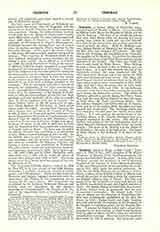

Trebnitz, a former abbey of Cistercian nuns, situated north of Breslau in Silesia. It was founded in 1203 by Duke Henry the Bearded of Silesia and his wife St. Hedwig. The story of its foundation relates that once Duke Henry when out hunting fell into a swamp from which he could not extricate himself. In return for the rescue from this perilous position he vowed to build the abbey. With St. Hedwig’s consent, Bishop Ekbert of Bamberg, her brother, chose the first nuns that occupied the convent. The first abbess was Petrussa; she was followed by Gertrude, the daughter of St. Hedwig. Up to 1515 the abbesses were first princesses of the Piast House and afterwards members of the nobility. The abbey was richly endowed with lands by Duke Henry. When Hedwig became a widow she went to live at Trebnitz and was buried there. It is said that towards the end of the thirteenth century the nuns numbered 120. In 1672 there were 32 nuns and 6 lay sisters; in 1805 there were 23 nuns and 6 lay sisters. The abbey suffered from all kinds of misfortunes both in the Middle Ages and in modern times: from famine in 1315, 1338, 1434, and 1617; from disastrous fires in 1413, 1432, 1464, 1486, 1505, 1595, and 1782. At the Reformation most of the nuns were Poles, as were the majority until during the eighteenth century. The Abbey of Trebnitz suffered so greatly during the Thirty Years War that the nuns fled to Poland, as they did again in 1663 when the Turks threatened Silesia. The last abbess, Dominica von Giller, died on August 17, 1810, and on November 11, 1810, the abbey was suppressed and secularized. The building, which was very extensive, was sold later and turned into a cloth factory. It is now used as the mother-house of the Trebnitz Sisters of St. Charles Borromeo and as a hospital conducted by the sisters. The church, a basilica with pillars in the late Romanesque style, to which Baroque additions were made, is now the parish church. The grave of St. Hedwig is in the chapel of St. Hedwig to the right of the high altar. The grave of Duke Henry I, her husband, is in front of the altar.
KLEMENS LOFFLER

